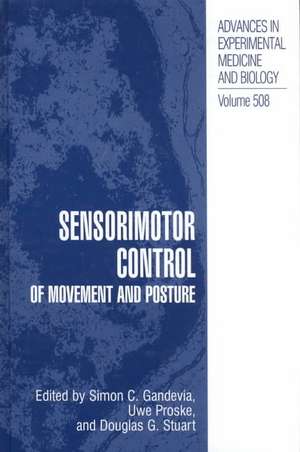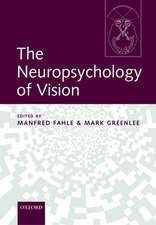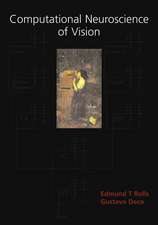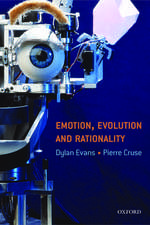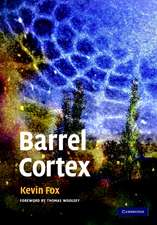Sensorimotor Control of Movement and Posture: Advances in Experimental Medicine and Biology, cartea 508
Editat de Simon C. Gandevia, Uwe Proske, Douglas G. Stuarten Limba Engleză Hardback – 31 iul 2002
| Toate formatele și edițiile | Preț | Express |
|---|---|---|
| Paperback (1) | 2106.23 lei 6-8 săpt. | |
| Springer Us – 5 noi 2012 | 2106.23 lei 6-8 săpt. | |
| Hardback (1) | 1843.42 lei 6-8 săpt. | |
| Springer Us – 31 iul 2002 | 1843.42 lei 6-8 săpt. |
Din seria Advances in Experimental Medicine and Biology
- 9%
 Preț: 719.56 lei
Preț: 719.56 lei - 5%
 Preț: 717.00 lei
Preț: 717.00 lei - 5%
 Preț: 717.00 lei
Preț: 717.00 lei - 15%
 Preț: 640.24 lei
Preț: 640.24 lei - 5%
 Preț: 715.71 lei
Preț: 715.71 lei - 5%
 Preț: 716.28 lei
Preț: 716.28 lei - 20%
 Preț: 691.93 lei
Preț: 691.93 lei - 5%
 Preț: 1031.00 lei
Preț: 1031.00 lei - 5%
 Preț: 820.42 lei
Preț: 820.42 lei - 5%
 Preț: 716.28 lei
Preț: 716.28 lei - 15%
 Preț: 641.38 lei
Preț: 641.38 lei - 5%
 Preț: 717.20 lei
Preț: 717.20 lei - 5%
 Preț: 715.35 lei
Preț: 715.35 lei - 5%
 Preț: 1113.83 lei
Preț: 1113.83 lei - 20%
 Preț: 1161.71 lei
Preț: 1161.71 lei - 5%
 Preț: 1170.51 lei
Preț: 1170.51 lei - 18%
 Preț: 1119.87 lei
Preț: 1119.87 lei - 5%
 Preț: 1288.48 lei
Preț: 1288.48 lei - 5%
 Preț: 1164.67 lei
Preț: 1164.67 lei - 5%
 Preț: 1101.73 lei
Preț: 1101.73 lei - 18%
 Preț: 1123.67 lei
Preț: 1123.67 lei - 5%
 Preț: 1435.64 lei
Preț: 1435.64 lei - 20%
 Preț: 1044.10 lei
Preț: 1044.10 lei - 18%
 Preț: 946.39 lei
Preț: 946.39 lei - 5%
 Preț: 292.57 lei
Preț: 292.57 lei - 18%
 Preț: 957.62 lei
Preț: 957.62 lei - 18%
 Preț: 1235.76 lei
Preț: 1235.76 lei - 5%
 Preț: 1231.55 lei
Preț: 1231.55 lei - 5%
 Preț: 1292.30 lei
Preț: 1292.30 lei - 5%
 Preț: 1102.10 lei
Preț: 1102.10 lei - 18%
 Preț: 1132.81 lei
Preț: 1132.81 lei - 5%
 Preț: 1165.19 lei
Preț: 1165.19 lei - 5%
 Preț: 1418.48 lei
Preț: 1418.48 lei - 5%
 Preț: 1305.63 lei
Preț: 1305.63 lei - 18%
 Preț: 1417.72 lei
Preț: 1417.72 lei - 18%
 Preț: 1412.99 lei
Preț: 1412.99 lei - 24%
 Preț: 806.15 lei
Preț: 806.15 lei - 18%
 Preț: 1243.29 lei
Preț: 1243.29 lei - 5%
 Preț: 1429.44 lei
Preț: 1429.44 lei - 5%
 Preț: 1618.70 lei
Preț: 1618.70 lei - 5%
 Preț: 1305.12 lei
Preț: 1305.12 lei - 18%
 Preț: 1124.92 lei
Preț: 1124.92 lei - 5%
 Preț: 1097.54 lei
Preț: 1097.54 lei - 15%
 Preț: 649.87 lei
Preț: 649.87 lei - 5%
 Preț: 1097.54 lei
Preț: 1097.54 lei - 18%
 Preț: 945.79 lei
Preț: 945.79 lei - 5%
 Preț: 1123.13 lei
Preț: 1123.13 lei - 20%
 Preț: 816.43 lei
Preț: 816.43 lei
Preț: 1843.42 lei
Preț vechi: 2248.07 lei
-18% Nou
Puncte Express: 2765
Preț estimativ în valută:
352.75€ • 369.98$ • 293.65£
352.75€ • 369.98$ • 293.65£
Carte tipărită la comandă
Livrare economică 01-15 aprilie
Preluare comenzi: 021 569.72.76
Specificații
ISBN-13: 9780306472855
ISBN-10: 0306472856
Pagini: 518
Ilustrații: XXIII, 518 p.
Dimensiuni: 178 x 254 x 40 mm
Greutate: 1.21 kg
Ediția:2002
Editura: Springer Us
Colecția Springer
Seria Advances in Experimental Medicine and Biology
Locul publicării:New York, NY, United States
ISBN-10: 0306472856
Pagini: 518
Ilustrații: XXIII, 518 p.
Dimensiuni: 178 x 254 x 40 mm
Greutate: 1.21 kg
Ediția:2002
Editura: Springer Us
Colecția Springer
Seria Advances in Experimental Medicine and Biology
Locul publicării:New York, NY, United States
Public țintă
ResearchCuprins
Section I: Impulse Initiation and Central Transmission from Muscle and Skin.- 1. Signalling Properties of Muscle Spindles and Tendon Organs.- 2. Evidence for Activity-Dependent Modulation of Sensory-Terminal Excitability in Spindles by Glutamate Release from Synaptic-Like Vesicles.- 3. Electrophysiology of Corneal Cold Receptor Nerve Terminals.- 4. Discharge Properties of Group III and IV Muscle Afferents.- 5. Effects of Activity on Axonal Excitability: Implications for Motor Control Studies.- 6. Reflexes in the Hand: Strong Synaptic Coupling Between Single Tactile Afferents and Spinal Motoneurones.- 7. The Synaptic Linkage for Tactile and Kinaesthetic Inputs to the Dorsal Column Nuclei.- Section II: Proprioception in Limb Movements.- 8. Proprioception: Peripheral Inputs and Perceptual Interactions.- 9. Adaptation to Coriolis Force Perturbation of Movement Trajectory: Role of Proprioceptive and Cutaneous Somatosensory Feedback.- 10. Velocity Perception and Proprioception.- 11. The Effect of Muscle Contraction on Kinaesthesia.- 12. Proprioception and Joint Pathology.- Section III: Afferent Contributions to Balance and Posture.- 13. Consequences and Assessment of Human Vestibular Failure: Implications for Postural Control.- 14. The Role of Cutaneous Receptors in the Foot.- 15. What does Galvanic Vestibular Stimulation Stimulate?.- 16. Sensory Interactions for Human Balance Control Revealed by Galvanic Vestibular Stimulation.- 17. Vestibulospinal Control of Posture.- 18. Sensory Contributions to the Control of Stance: A Posture Control Model.- Section IV: Motoneurones and Motor Units.- 19. Selectivity of the Central Control of Sensory Information in the Mammalian Spinal Cord.- 20. Some Unresolved Issues in Motor Unit Research.- 21. Presynaptic and Disynaptic Inhibition Induced by Group I Muscle Afferents.- 22. Things We Know and Do Not Know about Motoneurones.- 23. A New Way of Using Modelling to Estimate the Size of a Motoneuron’s EPSP.- 24. What Can Be Learned about Motoneurone Properties from Studying Firing Patterns?.- 25. Relative Strengths and Distributions of Different Sources of Synaptic Input to the Motoneurone Pool: Implications for Motor Unit Recruitment.- 26. Plateau Potentials and Their Role in Regulating Motoneuronal Firing.- 27. Mechanisms Causing Plateau Potentials in Spinal Motoneurones.- 28. Recent Evidence for Plateau Potentials in Human Motoneurones.- 29. Patterns of Pathological Firing in Human Motor Units.- Section V: Propriospinal Neurones and Spinal Reflexes.- 30. Reflections on Spinal Reflexes.- 31. Spinal Intemeurones: Re-evaluation and Controversy.- 32. Functional Properties of Primate Spinal Intemeurones during Voluntary Hand Movements.- 33. A Cervical Propriospinal System in Man.- 34. Premotoneuronal and Direct Corticomotoneuronal Control in the Cat and Macaque Monkey.- 35. Interspecies Comparisons for the C3-C4 Propriospinal System: Unresolved Issues.- 36. Central Nervous System Lesions and Segmental Activity.- 37. Reflex Mechanisms for Motor Impairment in Spinal Cord Injury.- Section VI: Locomotion.- 38. Give Proprioceptors a Chance.- 39. Role of the Fusimotor System in Locomotion.- 40. The Role of Proprioceptive Feedback in the Regulation and Adaptation of Locomotor Activity.- 41. Sensory Control of Locomotion: Reflexes versus Higher-Level Control.- 42. Reflex Excitation of Muscles during Human Walking.- 43. H Reflexes Recorded during Locomotion.- Section VII: Supraspinal Control of Movement.- 44. fMRI Studies of the Sensory and Motor Areas Involved in Movement.- 45. Dynamic Use of Tactile AfferentSignals in Control of Dexterous Manipulation.- 46. Motor Cortex and the Distributed Anatomy of Finger Movements.- 47. Reward-Based Planning of Motor Selection in the Rostral Cingulate Motor Area.- 48. Functional Differences in Corticospinal Projections from Macaque Primary Motor Cortex and Supplementary Motor Area.- 49. Corticospinal Transmission After Voluntary Contractions.- 50. Afferent and Cortical Control of Human Masticatory Muscles.- 51. Mechanisms for Acute Changes in Sensory Maps.- 52. Vision as Motivation: Interhemispheric Oscillation Alters Perception.- Section VIII: Mechanics and Movement.- 53. Musculoskeletal Mechanics: A Foundation of Motor Physiology.- 54. The Importance of Biomechanics.- 55. The Role of the Length-Tension Curve in the Control of Movement.- 56. Intramuscular Force Transmission.- 57. Muscle and Tendon Relations in Humans: Power Enhancement in Counter-Movement Exercise.- 58. Relationship Between Neural Drive and Mechanical Effect in the Respiratory System.
